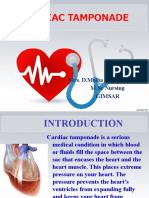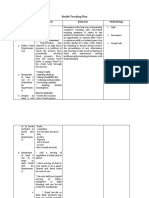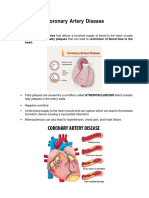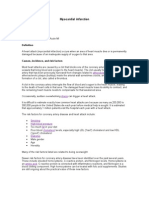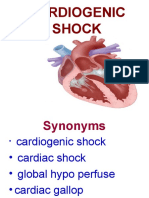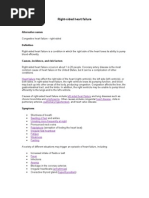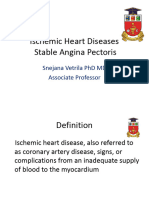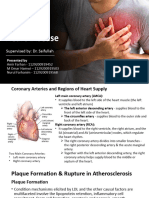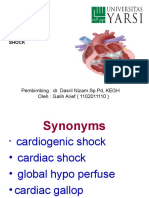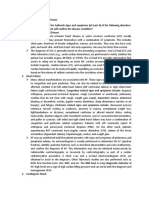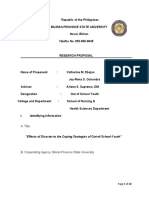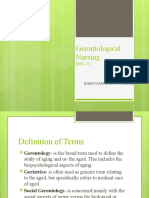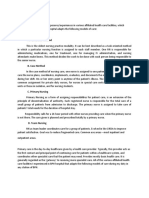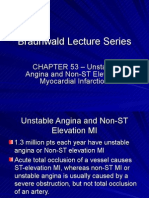0 ratings0% found this document useful (0 votes)
117 viewsPathophysiology of Congestive Heart Failure: Reported By: Jay - Ann M. Cabia BSN II-A
Pathophysiology of Congestive Heart Failure: Reported By: Jay - Ann M. Cabia BSN II-A
Uploaded by
joyrena ochondraCongestive heart failure occurs when the heart muscle does not pump blood efficiently due to conditions that weaken or stiffen the heart over time. Common causes include hypertension, heart valve defects, cardiomyopathy, myocarditis, and congenital heart defects. Signs and symptoms include shortness of breath, fatigue, swelling, and cough. Diagnostic tests include blood tests, chest X-ray, echocardiogram, and stress test. Treatment may include lifestyle changes, medications, surgery such as valve replacement or transplant, and management of symptoms. Prognosis depends on factors like functional status and underlying heart disease.
Copyright:
© All Rights Reserved
Available Formats
Download as PPTX, PDF, TXT or read online from Scribd
Pathophysiology of Congestive Heart Failure: Reported By: Jay - Ann M. Cabia BSN II-A
Pathophysiology of Congestive Heart Failure: Reported By: Jay - Ann M. Cabia BSN II-A
Uploaded by
joyrena ochondra0 ratings0% found this document useful (0 votes)
117 views21 pagesCongestive heart failure occurs when the heart muscle does not pump blood efficiently due to conditions that weaken or stiffen the heart over time. Common causes include hypertension, heart valve defects, cardiomyopathy, myocarditis, and congenital heart defects. Signs and symptoms include shortness of breath, fatigue, swelling, and cough. Diagnostic tests include blood tests, chest X-ray, echocardiogram, and stress test. Treatment may include lifestyle changes, medications, surgery such as valve replacement or transplant, and management of symptoms. Prognosis depends on factors like functional status and underlying heart disease.
Original Title
PPP222 CHF
Copyright
© © All Rights Reserved
Available Formats
PPTX, PDF, TXT or read online from Scribd
Share this document
Did you find this document useful?
Is this content inappropriate?
Congestive heart failure occurs when the heart muscle does not pump blood efficiently due to conditions that weaken or stiffen the heart over time. Common causes include hypertension, heart valve defects, cardiomyopathy, myocarditis, and congenital heart defects. Signs and symptoms include shortness of breath, fatigue, swelling, and cough. Diagnostic tests include blood tests, chest X-ray, echocardiogram, and stress test. Treatment may include lifestyle changes, medications, surgery such as valve replacement or transplant, and management of symptoms. Prognosis depends on factors like functional status and underlying heart disease.
Copyright:
© All Rights Reserved
Available Formats
Download as PPTX, PDF, TXT or read online from Scribd
Download as pptx, pdf, or txt
0 ratings0% found this document useful (0 votes)
117 views21 pagesPathophysiology of Congestive Heart Failure: Reported By: Jay - Ann M. Cabia BSN II-A
Pathophysiology of Congestive Heart Failure: Reported By: Jay - Ann M. Cabia BSN II-A
Uploaded by
joyrena ochondraCongestive heart failure occurs when the heart muscle does not pump blood efficiently due to conditions that weaken or stiffen the heart over time. Common causes include hypertension, heart valve defects, cardiomyopathy, myocarditis, and congenital heart defects. Signs and symptoms include shortness of breath, fatigue, swelling, and cough. Diagnostic tests include blood tests, chest X-ray, echocardiogram, and stress test. Treatment may include lifestyle changes, medications, surgery such as valve replacement or transplant, and management of symptoms. Prognosis depends on factors like functional status and underlying heart disease.
Copyright:
© All Rights Reserved
Available Formats
Download as PPTX, PDF, TXT or read online from Scribd
Download as pptx, pdf, or txt
You are on page 1of 21
PATHOPHYSIOLOGY OF
CONGESTIVE HEART
FAILURE
Reported By: Jay_Ann M. Cabia BSN II-A
Heart Failure
• Heart failure, sometimes known as congestive heart failure,
occurs when your heart muscle doesn't pump blood as well
as it should.
• Certain conditions, such as narrowed arteries in your heart
(coronary artery disease) or high blood pressure, gradually
leave your heart too weak or stiff to fill and pump efficiently.
Pathophysiology
Schematic Diagram
CAUSES
• HYPERTENSION = If your blood pressure is high, your heart has
to work harder than it should to circulate blood throughout your
body. Over time, this extra exertion can make your heart muscle
too stiff or too weak to effectively pump blood.
• FAULTY HEART VALVES = The valves of your heart keep blood
flowing in the proper direction through the heart. A damaged valve
due to a heart defect, coronary artery disease or heart infection
forces your heart to work harder, which can weaken it over time.
• CARDIOMYOPATHY = Heart muscle damage
(cardiomyopathy) can have many causes, including several
diseases, infections, alcohol abuse and the toxic effect of drugs,
such as cocaine or some drugs used for chemotherapy. Genetic
factors also can play a role.
• MYOCARDITIS = Myocarditis is an inflammation of the heart
muscle. It's most commonly caused by a virus and can lead to
left-sided heart failure.
• CONGENITAL HEART DEFECTS = If your heart and its
chambers or valves haven't formed correctly, the healthy parts of
your heart have to work harder to pump blood through your heart,
which, in turn, may lead to heart failure.
SIGNS AND SYMPTOMS
Heart failure can be ongoing (chronic), or your condition may
start suddenly (acute).
Heart failure signs and symptoms may include:
• Shortness of breath (dyspnea) when you exert yourself or
when you lie down
• Fatigue and weakness
• Swelling (edema) in your legs, ankles and feet
• Rapid or irregular heartbeat
• Reduced ability to exercise
• Persistent cough or wheezing with white or pink blood-tinged
phlegm
• Increased need to urinate at night
• Swelling of your abdomen (ascites)
• Very rapid weight gain from fluid retention
• Lack of appetite and nausea
• Difficulty concentrating or decreased alertness
• Sudden, severe shortness of breath and coughing up pink,
foamy mucus
• Chest pain if your heart failure is caused by a heart attack
DIAGNOSTIC TEST
After the physical exam, your doctor may also order some of these tests:
• Blood tests. Your doctor may take a blood sample to look for signs of
diseases that can affect the heart. He or she may also check for a
chemical called N-terminal pro-B-type natriuretic peptide (NT-proBNP) if
your diagnosis isn't certain after other tests.
• Chest X-ray. X-ray images help your doctor see the condition of your
lungs and heart. Your doctor can also use an X-ray to diagnose conditions
other than heart failure that may explain your signs and symptoms.
• Electrocardiogram (ECG). This test records the electrical activity of your
heart through electrodes attached to your skin. It helps your doctor
diagnose heart rhythm problems and damage to your heart.
• Echocardiogram. An echocardiogram uses sound waves to produce a
video image of your heart. This test can help doctors see the size and
shape of your heart along with any abnormalities. An echocardiogram
measures your ejection fraction, an important measurement of how well
your heart is pumping, and which is used to help classify heart failure and
guide treatment.
• Stress test. Stress tests measure the health of your heart by how it
responds to exertion. You may be asked to walk on a treadmill while
attached to an ECG machine,or you may receive a drug intravenously that
stimulates your heart similar to exercise.
• Sometimes the stress test can be done while wearing a mask that
measures the ability of your heart and lungs to take in oxygen and breathe
out carbon dioxide. If your doctor also wants to see images of your heart
while you're exercising, he or she may use imaging techniques to visualize
your heart during the test.
• Cardiac computerized tomography (CT) scan. In a cardiac CT
scan, you lie on a table inside a doughnut-shaped machine. An X-
ray tube inside the machine rotates around your body and collects
images of your heart and chest.
• Magnetic resonance imaging (MRI). In a cardiac MRI, you lie on
a table inside a long tubelike machine that produces a magnetic
field, which aligns atomic particles in some of your cells. Radio
waves are broadcast toward these aligned particles, producing
signals that create images of your heart.
• Coronary angiogram. In this test, a thin, flexible tube (catheter)
is inserted into a blood vessel at your groin or in your arm and
guided through the aorta into your coronary arteries. A dye
injected through the catheter makes the arteries supplying your
heart visible on an X-ray, helping doctors spot blockages.
• Myocardial biopsy. In this test, your doctor inserts a small,
flexible biopsy cord into a vein in your neck or groin, and small
pieces of the heart muscle are taken. This test may be performed
to diagnose certain types of heart muscle diseases that cause
heart failure.
MEDICAL INTERVENTIONS
Surgery and medical devices
In some cases, doctors recommend surgery to treat the
underlying problem that led to heart failure. Some treatments being
studied and used in certain people include:
• Coronary bypass surgery. If severely blocked arteries are
contributing to your heart failure, your doctor may recommend
coronary artery bypass surgery. In this procedure, blood vessels
from your leg, arm or chest bypass a blocked artery in your heart
to allow blood to flow through your heart more freely.
• Heart valve repair or replacement. If a faulty heart valve causes
your heart failure, your doctor may recommend repairing or
replacing the valve. The surgeon can modify the original valve to
eliminate backward blood flow. Surgeons can also repair the
valve by reconnecting valve leaflets or by removing excess valve
tissue so that the leaflets can close tightly. Sometimes repairing
the valve includes tightening or replacing the ring around the
valve (annuloplasty).
• Heart transplant. Some people have such severe heart failure
that surgery or medications don't help. They may need to have
their diseased heart replaced with a healthy donor heart.
PROGNOSIS
• Factors determining prognosis in 100 patients with recent onset of
congestive heart failure (CHF) were evaluated. The 1 year, 3 year, 5 year,
and 10 year survival rates in the entire CHF group were 78.5%, 59.8%,
50.4% and 14.7%, respectively. No correlations between age, sex, heart
rate and cardiothoracic ratio, and the cumulative survival rate were found.
The prognosis of patients with CHF due to underlying coronary artery
disease or primary cardiomyopathy was poor compared with that of
patients with other types of heart disease. Patients whose NYHA
classification was class III or VI had a significantly lower survival rate than
those in class II. Patients with lower left ventricular stroke work and
consecutive ventricular premature depolarization also had a significantly
lower survival rate. These results suggest that functional status, underlying
heart disease, left ventricular stroke work, and the presence of ventricular
tachycardia provide important information regarding the long-term
prognosis in patients with congestive heart failure.
NURSING DIAGNOSIS
• Activity intolerance (or risk for activity intolerance) related to
imbalance between oxygen supply and demand because of
decreased CO
• Excess fluid volume related to excess fluid or sodium intake and
retention of fluid because of HF and its medical therapy
• Anxiety related to breathlessness and restlessness from
inadequate oxygenation
• Powerlessness related to inability to perform role responsibilities
because of chronic illness and hospitalizations
• Noncompliance related to lack of knowledge
NURSING INTERVENTIONS
• Auscultate apical pulse, assess heart rate, rhythm. Document
dysrhythmia if telemetry is available.
Rationale: Tachycardia is usually present (even at rest) to
compensate for decreased ventricular contractility. Premature atrial
contractions (PACs), paroxysmal atrial tachycardia (PAT), PVCs,
multifocal atrial tachycardia (MAT), and atrial fibrillation (AF) are
common dysrhythmias associated with HF, although others may
also occur.
• Check vital signs before and immediately after activity, especially
if patient is receiving vasodilators, diuretics, or beta-blockers
Rationale : Orthostatic hypotension can occur with activity because
of medication effect (vasodilation), fluid shifts (diuresis), or
compromised cardiac pumping function.
• Provide assistance with self-care activities as indicated.
Intersperse activity periods with rest periods.
Rationale : Meets patient’s personal care needs without undue
myocardial stress and excessive oxygen demand.
• Instruct patient in effective coughing, deep breathing.
Rationale : Clears airways and facilitates oxygen delivery.
• Place patient in Fowler’s position and give supplemental oxygen.
Rationale : To help patient breath more easily and promote
maximum chest expansion.
• Observe breathing pattern for SOB, nasal flaring, pursed-lip
breathing or prolonged expiratory phase and use of accessory
muscles
Rationale : Identifies increased work of breathing.
Thank you !
You might also like
- Cardiology NotesDocument13 pagesCardiology NotesFreeNursingNotes78% (9)
- Lesson3-Post Assessment ActiviyDocument6 pagesLesson3-Post Assessment Activiyjoyrena ochondra100% (3)
- NCM 106 Acute Biologic CrisisDocument142 pagesNCM 106 Acute Biologic CrisisEllamae Chua88% (8)
- NURSING CARE PLAN of Hodgkin's Lymphoma: Assessment Nursing Diagnosis Planning Nursing Interventions Rationale EvaluationDocument5 pagesNURSING CARE PLAN of Hodgkin's Lymphoma: Assessment Nursing Diagnosis Planning Nursing Interventions Rationale Evaluationjoyrena ochondraNo ratings yet
- Humans Body Systems QuestionsDocument2 pagesHumans Body Systems QuestionsMichael Plexousakis100% (1)
- Cardiac Tamponade: Mrs. D.Melba Sahaya Sweety.D M.SC Nursing GimsarDocument23 pagesCardiac Tamponade: Mrs. D.Melba Sahaya Sweety.D M.SC Nursing GimsarD. Melba S.S ChinnaNo ratings yet
- OCHONDRA CA - FinalExam - 2020Document15 pagesOCHONDRA CA - FinalExam - 2020joyrena ochondraNo ratings yet
- OCHONDRA CA - FinalExam - 2020Document15 pagesOCHONDRA CA - FinalExam - 2020joyrena ochondraNo ratings yet
- Health Teaching Plan: Learning Objectives Content Rationale MethodologyDocument5 pagesHealth Teaching Plan: Learning Objectives Content Rationale Methodologyjoyrena ochondraNo ratings yet
- SLE Gordon's Functional Assessment & Physical AssessmentDocument17 pagesSLE Gordon's Functional Assessment & Physical Assessmentjoyrena ochondraNo ratings yet
- Introduction To Gerontological Nursing: - Jerald I. Corpuz, RNDocument16 pagesIntroduction To Gerontological Nursing: - Jerald I. Corpuz, RNjoyrena ochondra100% (3)
- Level 1 HospitalDocument2 pagesLevel 1 Hospitaljoyrena ochondra100% (4)
- Poster1 Arrhythmia Recognition e PDFDocument1 pagePoster1 Arrhythmia Recognition e PDFPierf-17No ratings yet
- Complete Heart BlockDocument13 pagesComplete Heart BlockSubhranil MaityNo ratings yet
- Chronic Heart DiseasesDocument54 pagesChronic Heart DiseasesHazel Roda EstorqueNo ratings yet
- Congestive Cardiac FailureDocument45 pagesCongestive Cardiac FailureEndla SriniNo ratings yet
- Congestive Heart FailureDocument31 pagesCongestive Heart FailurevaishaliparhadakNo ratings yet
- يسر صلاح مهدي،تقرير طب باطني نظريDocument8 pagesيسر صلاح مهدي،تقرير طب باطني نظريyosryoso1No ratings yet
- Cad, MiDocument23 pagesCad, MiSandeep ChaudharyNo ratings yet
- Heartfailurepptsam 170511135108Document48 pagesHeartfailurepptsam 170511135108enam professorNo ratings yet
- Rabino Heartfailure Report NCM116Document15 pagesRabino Heartfailure Report NCM116AZRIEL JOYCE G. RABINONo ratings yet
- MEDICAL DISORDERSDocument94 pagesMEDICAL DISORDERSkerentajNo ratings yet
- Congestive Heart FailureDocument47 pagesCongestive Heart FailureRajesh Sharma100% (2)
- 9 CsaDocument34 pages9 Csaمحمد بن الصادقNo ratings yet
- Surgery Midterm 1 PDFDocument100 pagesSurgery Midterm 1 PDFZllison Mae Teodoro MangabatNo ratings yet
- Hosp#2Document4 pagesHosp#2tsukiyaNo ratings yet
- Congestive Cardiac FailureDocument49 pagesCongestive Cardiac FailureHampson MalekanoNo ratings yet
- Case Analysis:: Myocardial InfarctionDocument76 pagesCase Analysis:: Myocardial InfarctionIpeNo ratings yet
- Cardiogenic ShockDocument20 pagesCardiogenic Shockanimesh pandaNo ratings yet
- Myocardial Infarction: Alternative NamesDocument5 pagesMyocardial Infarction: Alternative NamesKhalid Mahmud ArifinNo ratings yet
- TextDocument2 pagesTextaashutosh.singh0805No ratings yet
- Coronary Artery Bypass Grafting: Coronary Bypass Surgery Is An Open-Heart Surgery, You MightDocument17 pagesCoronary Artery Bypass Grafting: Coronary Bypass Surgery Is An Open-Heart Surgery, You MightNuzhat FatimaNo ratings yet
- Cardiac TemponadeDocument18 pagesCardiac TemponadeDIVYA GANGWAR100% (1)
- Assignment 4Document12 pagesAssignment 4Eren MicaellaNo ratings yet
- Arrhythmia Assignment No 1Document7 pagesArrhythmia Assignment No 1mrjq62097No ratings yet
- Heart Failure NewDocument40 pagesHeart Failure NewRoshani sharmaNo ratings yet
- Nursing Care Plans For Decreased Cardiac OutputDocument4 pagesNursing Care Plans For Decreased Cardiac OutputCarmela Balderas Romantco80% (5)
- Cardiogenic ShockDocument49 pagesCardiogenic Shockmaibejose0% (1)
- Pathologies Affecting Blood VesselDocument11 pagesPathologies Affecting Blood VesselroselynroukayaNo ratings yet
- Patofisiologi Shock CardiogenicDocument44 pagesPatofisiologi Shock CardiogenicGalih Arief Harimurti Wawolumaja100% (2)
- Right-Sided Heart FailureDocument4 pagesRight-Sided Heart FailureKhalid Mahmud ArifinNo ratings yet
- Coronary Heart DiseaseDocument11 pagesCoronary Heart DiseaseZaryna TohNo ratings yet
- NCD Lecture-Cardiovascular DisordersDocument133 pagesNCD Lecture-Cardiovascular DisordersYashvi SinghNo ratings yet
- Cardiac Arrest: Ratheesh R.LDocument29 pagesCardiac Arrest: Ratheesh R.LYazan HabaibyNo ratings yet
- Oup 8Document10 pagesOup 8komaginainna038No ratings yet
- Reading CardiologyDocument6 pagesReading CardiologyedarisofficeNo ratings yet
- Coronary Artery DiseaseDocument9 pagesCoronary Artery DiseaseRantini Indrayani100% (1)
- Cardiovascular Review II: Ana H. Corona, MSN, FNP-C Nursing Instructor October 2007Document79 pagesCardiovascular Review II: Ana H. Corona, MSN, FNP-C Nursing Instructor October 2007leesteph78No ratings yet
- 7. Stable Angina Pectoris 2018 pptDocument43 pages7. Stable Angina Pectoris 2018 pptOsama HassanNo ratings yet
- Acute Coronary Syndrome (ACS)Document20 pagesAcute Coronary Syndrome (ACS)Benjiber R. SilvaNo ratings yet
- Coronary Heart DiseaseDocument12 pagesCoronary Heart DiseaseAji Prima Putra67% (3)
- MIT Lecture CardioDocument161 pagesMIT Lecture Cardioramish.riazNo ratings yet
- Caring For A Heart Attack Teaching PlanDocument15 pagesCaring For A Heart Attack Teaching Planapi-676173784No ratings yet
- Acute Coronary Syndrome PDFDocument12 pagesAcute Coronary Syndrome PDFElsy MayjoNo ratings yet
- Ischemic Heart DiseaseDocument64 pagesIschemic Heart DiseaseOmar HamwiNo ratings yet
- Applied Anatomy of Heart CirclationDocument7 pagesApplied Anatomy of Heart Circlationαπικλετ ΞλNo ratings yet
- Medicine Lecture 17,18Document51 pagesMedicine Lecture 17,18Nayela AkramNo ratings yet
- Coronary Artery Disease: By. Saiha AlinaDocument19 pagesCoronary Artery Disease: By. Saiha AlinasaihaNo ratings yet
- Kardiogenik SyokDocument43 pagesKardiogenik SyokGalih Arief Harimurti WawolumajaNo ratings yet
- 4B MS Midterm NotespdfDocument23 pages4B MS Midterm NotespdfNorbelisa Tabo-ac CadungganNo ratings yet
- Care of The Clients With Cardiovascular DiseasesDocument94 pagesCare of The Clients With Cardiovascular DiseasesSydney PellosisNo ratings yet
- Cardiac ArrestDocument8 pagesCardiac ArrestMICHELLE JOY GAYOSONo ratings yet
- Understanding Heart FailureDocument4 pagesUnderstanding Heart Failurekinarofelix12No ratings yet
- Medical Nursing Cardiovascular SystemDocument25 pagesMedical Nursing Cardiovascular SystemStephanie PrevostNo ratings yet
- Heart Attack AnnaDocument7 pagesHeart Attack Annaannamuhamad81No ratings yet
- Right Sided Heart FailureDocument18 pagesRight Sided Heart FailureShaf Abubakar100% (1)
- Heart Failure and Pulmonary EdemaDocument60 pagesHeart Failure and Pulmonary EdemaYosra —No ratings yet
- DirectFileTopicDownload 7Document36 pagesDirectFileTopicDownload 7sesaeedhaniyah.dNo ratings yet
- Altered Tissue PerfusionDocument10 pagesAltered Tissue PerfusionLaurence ZernaNo ratings yet
- Mitral Valve Regurgitation, A Simple Guide To The Condition, Treatment And Related ConditionsFrom EverandMitral Valve Regurgitation, A Simple Guide To The Condition, Treatment And Related ConditionsNo ratings yet
- INTRODUCTION&THEORETICALDocument12 pagesINTRODUCTION&THEORETICALjoyrena ochondraNo ratings yet
- Research Proposal Ochondra&EbajanDocument20 pagesResearch Proposal Ochondra&Ebajanjoyrena ochondraNo ratings yet
- Case #1 Rle 418Document1 pageCase #1 Rle 418joyrena ochondraNo ratings yet
- Anxiety, Fatigue and Depression Final ProposalDocument14 pagesAnxiety, Fatigue and Depression Final Proposaljoyrena ochondraNo ratings yet
- Task 12,13Document1 pageTask 12,13joyrena ochondraNo ratings yet
- Formerly Naval State UniversityDocument9 pagesFormerly Naval State Universityjoyrena ochondraNo ratings yet
- Leadership and Management Task 13Document3 pagesLeadership and Management Task 13joyrena ochondraNo ratings yet
- Gerontological NursingDocument14 pagesGerontological Nursingjoyrena ochondra100% (1)
- NCM 417 MODULE Emergeny and Disaster NursingDocument5 pagesNCM 417 MODULE Emergeny and Disaster Nursingjoyrena ochondraNo ratings yet
- Formerly Naval State UniversityDocument6 pagesFormerly Naval State Universityjoyrena ochondraNo ratings yet
- Cues Nursing Diagnosis Scientific Basis Objectives Nursing Intervention Rationale EvaluationDocument11 pagesCues Nursing Diagnosis Scientific Basis Objectives Nursing Intervention Rationale Evaluationjoyrena ochondraNo ratings yet
- Source: Comparison of Eight and 12 Hour Shifts: Impacts On Health, Wellbeing, and Alertness During TheDocument1 pageSource: Comparison of Eight and 12 Hour Shifts: Impacts On Health, Wellbeing, and Alertness During Thejoyrena ochondraNo ratings yet
- Task 10Document1 pageTask 10joyrena ochondraNo ratings yet
- Systemic Lupus Erythematosus (SLE) : Genetic Factors Environmental FactorsDocument5 pagesSystemic Lupus Erythematosus (SLE) : Genetic Factors Environmental Factorsjoyrena ochondraNo ratings yet
- Drug Study of SleDocument7 pagesDrug Study of Slejoyrena ochondraNo ratings yet
- CV 0000111Document2 pagesCV 0000111shamseerNo ratings yet
- 37 Pediatric Cardiopulmonary BypassDocument19 pages37 Pediatric Cardiopulmonary BypassDavid Montoya100% (2)
- Braunwald - UA and NSTEMIDocument49 pagesBraunwald - UA and NSTEMIusfcards100% (2)
- CVS AssessmentDocument119 pagesCVS AssessmentAbdurehman AyeleNo ratings yet
- General Expressions in Medical DiagnosisDocument6 pagesGeneral Expressions in Medical DiagnosisSergej ElekNo ratings yet
- Blood Circulation QuestionsDocument2 pagesBlood Circulation QuestionsMiran El-MaghrabiNo ratings yet
- Acls Algorithms 2012Document12 pagesAcls Algorithms 2012kivuNo ratings yet
- High Blood PressureDocument4 pagesHigh Blood PressureMacalalad, Charles JoshuaNo ratings yet
- Cardiovascular System PDFDocument12 pagesCardiovascular System PDFVon Valentine MhuteNo ratings yet
- Sample AB4 U1 1Document8 pagesSample AB4 U1 1Fernando González BuenoNo ratings yet
- Engr / Brae 213: Bioengineering Fundamentals: Spring 2015 James Eason (Jceason@calpoly - Edu)Document25 pagesEngr / Brae 213: Bioengineering Fundamentals: Spring 2015 James Eason (Jceason@calpoly - Edu)bwNorYNo ratings yet
- Log Book FIACTADocument16 pagesLog Book FIACTAPooja JakharNo ratings yet
- Raksha Yadav B.SC Nursing 2 Year Aiims, JodhpurDocument22 pagesRaksha Yadav B.SC Nursing 2 Year Aiims, JodhpurrohitNo ratings yet
- DETAILED LESSON PLAN GRADE 6 BIOLOGY ExpirementDocument11 pagesDETAILED LESSON PLAN GRADE 6 BIOLOGY ExpirementLoiweza AbagaNo ratings yet
- G8 Reviewer - 3rd GradingDocument48 pagesG8 Reviewer - 3rd GradingAhron PatauegNo ratings yet
- Anatomy, Physiology & Classification of Varicose Veins: Ravul Jindal, Bhanupriya Wadhawan, Piyush ChaudharyDocument4 pagesAnatomy, Physiology & Classification of Varicose Veins: Ravul Jindal, Bhanupriya Wadhawan, Piyush ChaudharyhyeNo ratings yet
- Zuñega - Congenital Heart Disease Educational MaterialsDocument13 pagesZuñega - Congenital Heart Disease Educational MaterialsAprilene Angel Balaque ZunegaNo ratings yet
- Bab Iv Daftar PustakaDocument2 pagesBab Iv Daftar Pustakaadwinas253No ratings yet
- How To Dissect RatDocument30 pagesHow To Dissect RatHend MaarofNo ratings yet
- Nursing Care PlanDocument1 pageNursing Care PlanJoanna Marie PacanoNo ratings yet
- V STD SCIENCE ln-4 - 3&4 WORKSHEETDocument8 pagesV STD SCIENCE ln-4 - 3&4 WORKSHEETMR SMILYNo ratings yet
- Differential DiagnosisDocument45 pagesDifferential DiagnosisKojo Yeboah EnchillNo ratings yet
- Anatomy and Physiology: Placement: First YearDocument12 pagesAnatomy and Physiology: Placement: First YearJerin CyriacNo ratings yet
- Viva QAs Thorax & Abdomen AnatomyDocument52 pagesViva QAs Thorax & Abdomen AnatomyNicholas MugishaNo ratings yet
- Arrhythmias Types, Pathophysiology AtfDocument9 pagesArrhythmias Types, Pathophysiology AtfAmir mohammad moori MohammadiNo ratings yet
- Applying Basic First AidDocument34 pagesApplying Basic First AidVhal ValenzuelaNo ratings yet
- Comprehensive Nurse Exam ReviewDocument5 pagesComprehensive Nurse Exam ReviewPrincess DelimaNo ratings yet
- Catatan Prof Hendry - Sudah DieditDocument38 pagesCatatan Prof Hendry - Sudah DieditBluehortensiaNo ratings yet





